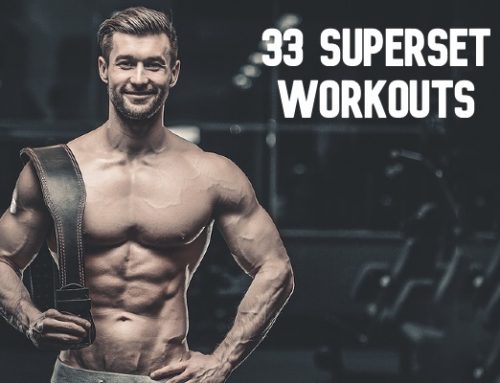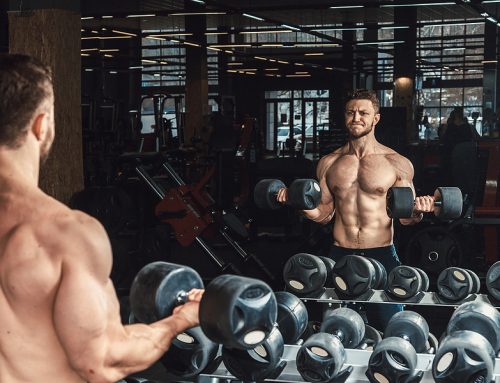Lately, I’ve been receiving a lot of requests for new and different ways to set up a weekly weight training schedule with 4 workouts per week (that are not upper lower splits).
The number of requests I’ve gotten for workout plans that take only 3 days per week has been on the rise as well. Since I covered 4 day workouts in a previous post, today I want to talk about 3 day workouts.
In this post, I’ll share 8 great ways you can set up a 3 days a week workout schedule. If you only want to train 3 days a week, but you still want to make serious muscle gains, this is exactly what you’ve been looking for.

Why So Many People Want 3 Days A Week Workouts
The increasing demand for lower frequency training schedules (4 days or even only 3 days a week ) isn’t surprising for a couple of reasons.
One is that here in our community, we have an older demographic that’s skewed toward the 40 to 60 age group. What a lot of people are finding is that as they age, they can’t recover from the advanced lifting programs they used to be able to follow when they were 20 and 30 somethings.
Even if they don’t have arthritis or orthopedic problems, training 5 days a week (let alone 6 or 7) leaves them feeling beat up and suffering from prolonged general fatigue and specific muscle soreness.
These kinds of high frequency (and or high volume) workouts can make even younger folks feel overtrained unless they have better than average muscle-building genetics and recovery capacity.
After trying less frequent training (4 days or even just 3 days per week), to their pleasant surprise, many people not only find themselves feeling refreshed and recovered, with fewer aches and pains, they also find that major muscle and strength gains keep coming in even with fewer workouts per week.
At the very least, people are discovering that with only 3 brief workouts a week, they can easily maintain the muscle they already have.
Another reason is that in virtually every formal survey ever done, most people say the number one perceived barrier to exercising consistently is lack of time.
But there are many ways you make workouts more time efficient. Using techniques like supersets, drop sets, rest pause or doing things as simple as cutting the rest periods between sets can all help make workouts shorter. You can see even more time efficiency techniques in our extensive report here:
The Best Time Efficient Training Tactics To Build Muscle And Strength, According To Science
What many people don’t consider is the idea that reducing training frequency – the number of workouts you do every 7 days – is also a efficiency tactic on it’s own.
After all, training only 3 days a week saves time even if you don’t use any of the other techniques that get you in and out of the gym quicker, right? When you combine a lower frequency with all the other time saving methods, your workouts can become unbelievably efficient. To think 3 workouts a week that only take 30 or 40 minutes can build significant muscle is exciting for busy people.
A common objection some people raise is they worry that 3 days a week of resistance training isn’t enough to get results. They’ve heard that at least 4 days a week is ideal and even 5 days a week or more is necessary for advanced lifters and physique athletes. (Some bodybuilders train 6 days a week, at least before competitions).
No doubt about it, training schedules with 4 workouts a week are popular, proven and can produce results virtually the same as 5 days a week or darn close to it. Our original default training program, TNB-28 calls for 4 workouts a week. (This is the training plan found in my book, Burn the Fat, Feed the Muscle. If you’re one of our new readers and you don’t have this classic book, it’s a must read and timeless reference guide. Grab it on Amazon here).
Since we already covered the best 4 days per week training programs in a previous article, in this post, we’ll focus only on 3 days a week muscle-building workouts. I’ll list 8 of the best routines, and I’ll also explain why this lower frequency of training can still be effective.
Is A 3 Day Workout Any Good?
Before I show you my list of 3 day training schedules, you might be wondering, “Can lifting only 3 days a week really build any major muscle? I thought you had to train almost every day to get maximum gains?”
Here’s one way to answer the question: The standard scientific guideline today is that about 10 sets per body part per week for major muscles (a little less for small muscles) can optimize muscle gains. If you do more than 10 sets (upwards of 20) per week, yes you can gain more muscle, but not much more. Plus, that all depends on whether you can recover from higher volume training. Not everyone has the genetics of a pro bodybuilder.
If you can hit this weekly volume benchmark with only 3 workouts a week, you can get near optimal gains.
What if you can’t? What if that’s too many sets? Well, you probably can if you try. 10 sets a week per muscle is like doing 4 sets for thighs on Monday, 3 sets for thighs on Wednesday and 3 sets for thighs on Friday. One exercise, 3 to 4 sets, 3 days a week. That’s do-able isn’t it?
If you can’t even swing that, good news is there’s also strong evidence that you can get significant muscle gains with only 6 sets per large muscle per week! That is not a lot of sets. It’s certainly not like being in the gym for hours at a time or lifting 6 days a week.
You may find it hard to believe, but there’s research showing that the minimum effective dose is even lower. If you do only 3 to 5 sets a week, you will build at least some muscle. This might be something like 1 or 2 really hard sets for each muscle, Monday, Wednesday And Friday. Is this optimal? No.
The point is, if you get your butt in the gym just 3 days a week and do something, you can make gains on infrequent workouts, as long as you follow a handful of best practice training principles which we teach here on our site and that I’ve been teaching in Burn the Fat, Feed the Muscle and my other training books for years.
Understanding how many sets it takes to stimulate muscle gain is one of the key principles for optimizing gains. As you’d expect, it’s also important to train hard (at a high enough intensity), which is pushing within a rep or two of failure. And perhaps the most important principle of all for long term continuing gains is to use progressive overload.
The Burn The Fat, Feed The Muscle Guide To Building Muscle With Progressive Overload Training
The Best 3-Days A Week Workouts
I hope what you just read is encouraging, especially if in the past you were one of those all or nothing types of lifters… “Eh, I can’t follow the perfect routine, so I might as well not train at all.”
Another thing that has stopped a lot of people is that they believe 3 days a week workouts are only for beginners. It’s true that full body workouts 3 days a week are a great way for beginners to start resistance training, but it’s false that 3 days a week workouts are only for beginners.
The 3 days a week workout can be used by anyone:
- It’s a great option for time restricted people who have busy weeks and simply can’t commit to more than 3 days a week in the gym.
- It’s a great option for people who don’t seem to recover well from doing a lot of volume for a single muscle or two in a single session. (bodybuilding-style training).
- It’s also a good choice for recreational lifters who just want to stay fit and aren’t planning on getting huge or posing on stage at the Mr Universe contest.
Most advanced bodybuilders use body part split routines, but even physique athletes could use 3 days a week workouts at times for various reasons. Their default method most of the time might be body part splits and higher weekly training frequency, but if their life circumstances change (new baby, moving, new job, need to recover from hard training cycle, or simply maintain for a while, etc), it could make perfect sense to scale back to only lifting 3 times week.
Lifting 3 times per week can be effective for building strength too, especially when the main focus is all the big compound exercises like squats, deadlifts, rows and presses. Proof here is the fact that some powerlifters train only 3 days per week and they’re pretty damn strong.
So with that introduction out of the way, now let’s start digging into some of the best 3 day workout schedule options.
3 Days A Week Full Body Training With Same 3 Workouts Each Day (Basic Full Body Workout)
To circle back to the beginner, there is one type of 3 day schedule in particular that works great in the early weeks or months of training. That is 3 full body workouts every other day (such as Monday, Wednesday and Friday), where the same exercises are repeated each workout.
The upside for beginners is that because weight lifting is a skill, the more often you practice an exercise in the novice stage, the quicker you develop that skill of using proper form.
The downside is that with advancing training age, the repeated bout effect sees to it that your body adapts more quickly. At some stage, more variety, or periodization (switching, cycling or alternating of exercises and training variables) is needed to keep gains coming.
Another downside is that doing the same exercises for a long training block of 2 to 3 months or more can get boring. Fortunately, with newbie gains coming in at a roaring pace in those early months, motivation is fairly easy to sustain.
Here’s what this basic lifting schedule looks like:

The important thing to remember about this type of 3 days a week workout schedule is that when you’re training your full body at every workout, you should not train two days in a row. Instead you should train every other day.
One thing you can do is customize this routine and any other 3 days a week workout in a variety of ways to suit your schedule and personal preferences. Here are some examples:
Monday, Wednesday, Saturday
Monday, Thursday, Saturday
Tuesday, Thursday, Saturday
Tuesday, Thursday, Sunday
Tuesday, Friday, Sunday
Wednesday, Friday, Sunday
You also have some flexibility where if you ever need to skip a day of training, you could still make up the workout before the week is over. If your standard schedule is Monday, Wednesday, and Friday, and if something comes up on Wednesday and you miss, you can simply hit the other two workouts on Thursday and Saturday.
3 Days A Week Full Body Training Rotating 2 Different Routines (A-B Full Body Workout)
Next, let’s look at the 3 days a week full body training schedule where you alternate between 2 different full body workouts with different exercises each time.
Remember how I mentioned that when you get more experienced and get more and more months of training under your belt how your body will adapt when you keep repeating the same workout over and over too many times in a row? And, how it also gets boring? Well, there’s a remedy for both those problems.
People in the intermediate to advanced stage usually do better with exercise rotation. What this means is you create 2 different workouts that still hit the whole body, but the exercises are different every other workout. On a Monday, Wednesday, Friday schedule, it would look like this:

Now remember, you are not going to do workout A every Monday and Friday. This is a rotating schedule, so on week 2 on Monday you pick up again with workout B. You continue to rotate workouts A and B every other session.
3 Days A Week Full Body Training Rotating 3 Different Routines (A-B-C Full Body Workout)
If you thought rotating 2 different full body routines was interesting, you can take this to the next level and create 3 different full body workouts, A, B and C, and rotate them.
Why would you want to rotate this many different workouts each week? Well, this will be even less boring and can keep even advanced lifters engaged and more interested in their training.
Even better, you get exposure to more exercises, which works your body from more angles. This could even help reduce overuse injuries which might be caused by doing the same exercise every time without any variety. You need consistency to achieve progressive overload, but variety is important too.
If there’s any downside, it might be that for less experienced lifters and beginners, this type of full body workout might feel overwhelming since you have to learn and correctly perform so many different exercises. There’s more complexity to this kind of schedule. That’s why this full body workout plan is better for advanced or at least intermediate trainees. Keeping with the popular Monday, Wednesday, Friday workout schedule, it would look like this:

In this case, you do follow the same schedule every week. Every Monday is full body workout A, every Wednesday is full body workout B and every Friday is full body workout C. It’s still a rotating schedule, but this time it fits evenly into a calendar week. (It’s weekly rotation not daily rotation). Because the workout changes more often, you’re less likely to adapt and plateau early in a training block, and you won’t get bored with this much day by day variety.
3 Workouts A Week With A 2 Day Rotating Split
Now is where is starts to get ultra interesting. That’s because here is where we are still training only 3 days a week, but we are leaving full body workouts behind and getting into 2-day splits. A 2 day split is where you train half your body one day and the other half the next.
There are a lot of ways to divide the body parts on a 2-day split, but for simplicity we’re going to use the tried and tested upper-lower split:
Workout A: upper body
Workout B: Lower body and abs
Maybe you’ve seen this split before (it’s popular with our Burn the Fat Inner Circle members). But the thing is, most people do this routine on a 4 days a week schedule like Monday, Tuesday, Thursday, Friday.
We’re using the same 2-way split but scaling it back to only 3 workouts a week. To make it work, we’re using the exercise rotation concept again. Here’s what it might look like if we keep sticking to a Monday, Wednesday, Friday schedule:

Again, remember what a rotating schedule means. Don’t do workout A Every Monday and every Friday. You’d be hitting your upper body twice a week and lower body only once a week. You’d have a hulking upper body and scrawny stick legs! Well, not really. You’d still look great. But you might be a little out of balance. That’s why we rotate the workouts A-B-A-B-A-B-A-B indefinitely every other session.
But wait… What if you’re a “quadzilla”, but you’re on the skinny side up top? Well in that case, you might want to hit upper body twice a week and lower body only once a week. Which is a perfect segue into… 3 workouts a week muscle priority training…
3 Workouts A Week With A 2 Day Rotating Split For Upper Body Priority Training
Many aesthetics-oriented lifters don’t feel like their body is well balanced. They look in the mirror and notice that some muscles are more developed than others. They want to do something to get their body looking better proportioned.
People like this sometimes do more sets per workout for priority muscles and or train those muscles more often. Creating a split routine where you work certain muscles more often than others is called body part priority training, or specialization training.
Granted, serious physique athletes usually train 4, 5, sometimes even 6 days a week, but yes, you can do body part priority training with only 3 workouts a week. Doing it on the 2-day split is a good way to schedule it. Here’s an example:

This is not a rotating schedule. This is a fixed schedule. Every Monday and Friday you train upper body (twice a week). Every Wednesday, you train lower body. It works the other way too…
3 Workouts A Week With A 2 Day Split For Lower Body Muscle Specialization
Everyone has different goals. And almost everyone has fast gaining body parts and slow gaining body parts. So it’s no surprise that so many people want to prioritize the slower growing muscles. For some people, it’s the lower body they want focus on more..
For lower body priority training, a 3 day workout schedule might look like this

Again this is not a rotating schedule. Every Monday and Friday is lower body day and every Wednesday is upper body day, every week.
The 3 X 3 Split: 3 Day Split, 3 Days A Week
Next, here’s how you schedule a 3 day split with only 3 workouts a week. I call this a 3 X 3 split.
Just so there’s no confusion, let me clarify that the term split or split routine is not how many workouts you do in a calendar week. A split or split routine is how many ways you split up your body parts.
You can do an upper – lower split, which is a 2-day split routine. Or in this 3 days a week workout routine, we use a 3 way split.
Here are the 2 most popular ways to run a 3-day split:
Push-pull-legs:
Day 1: Chest, shoulders, triceps (push muscles)
Day 2: Back, Biceps, Abs (pull muscles)
Day 3: Quads, hams, glutes/hips, calves (leg muscles)
3 Day Classic Muscle:
Day 1: Chest, Back, Abs
Day 2: Shoulders, Biceps, Triceps, Forearms
Day 3: Quads, hams, glutes/hips, calves
It’s unconventional to run a 3 day split 3 days a week. Some people would argue that it’s not optimal for muscle gains because each muscle is worked only once a week.
But remember what I said about the number of sets per week for optimizing muscle gains. There is scientific evidence that as long as you can hit those ideal volume benchmarks for the whole week, you can still make excellent gains.
Mostly, it means you have to do a lot of sets for each muscle group in a single workout to make this work well. A 3 day split with only 3 workouts per week looks like this if you choose the push-pull-legs split and schedule it Monday, Wednesday And Friday:

Some people would (sarcastically) call this a “bro split” (because it’s a bodybuilding-style body part split and each muscle is worked only once a week). This type of schedule may indeed not be optimal compared to some other splits, but it does work if you follow all the muscle-building training best practices, including hitting the weekly volume benchmarks. And some people really like it.
The 2/1 Hybrid Split 3 Days A Week
Now, here is one of the most unique ways to set up a split routine of all. It’s called a Hybrid Split
This is where you don’t do only full body workouts and you don’t do only split workouts either. You combine both into the same week. Previously, we published a 5 day hybrid split routine called 2/3 Hybrid M.A.S.S. And just this month we released a 4 day program called 3/1 Hybrid Muscle. But as I’ve mentioned in this post, not everyone wants to train 4 days a week, let alone 5
That’s why in January, we will be releasing the third in the Hybrid Muscle Trilogy, a program called 2/1 Hybrid Muscle. I’ll be writing more about this new and unique 3 day program in upcoming posts, but for today, let me show you how the split routine works:

As you can see, this is an unusual training schedule that includes two days using an upper-lower split, and then a full body workout. It’s unique and incredibly effective because each muscle is worked two days a week. It’s also time efficient.
Wrapping Up
I hope this post gave you a lot of great ideas for different weekly schedules you can try.
I realize I only gave you weekly training schedules, not entire workout routines with exercises, sets, reps and other training variables. But the whole idea of this post was to answer the question in the title, “What Are The Best 3 Days A Week Workout Schedules For Building Muscle?” Plus, if I kept going on listing full workout routines, this blog post would scroll for pages and end up the length of a small book.
Keep your eye out for future posts here at Burn the Fat Blog, because I’ll be sharing some examples of what a complete 3 days a week workout would look like, including exercises, sets, and reps and more tips to get the most out of 3 day training plans.
For access to our library of 16 complete training plans, including 3, 4, and 5 days a week schedules, join the Burn the Fat Inner Circle. Membership includes access to the entire archive of previous releases as well as our brand new (just released December 2022) 3/1 Hybrid muscle program (a 4-days per week muscle building plan). Join in December and you lock in (get “grandfathered”) the current low monthly rate before rates go up next year:
NOT A MEMBER? To learn more about joining Burn the Fat Inner Circle, CLICK HERE
MEMBERS: To browse our Burn the Fat Feed the Muscle training program library CLICK HERE
Until next time,
Train hard and expect success!
-Tom Venuto, Author of, Burn the Fat, Feed the Muscle (BFFM)
Author, The BFFM Guide To Flexible Meal Planning For Fat Loss
Founder, Burn the Fat Inner Circle
PS. Even if you have a great training plan, you won’t get far if you don’t have your nutrition dialed in. If you need help with meal planning, be sure to check out The Burn the Fat, Feed the Muscle Guide To Meal Planning For Fat Loss.

Tom Venuto is a natural bodybuilding and fat loss coach. He is also a recipe creator specializing in fat-burning, muscle-building cooking. Tom is a former competitive bodybuilder and is today a full-time fitness writer, blogger, and author. His book, Burn The Fat, Feed The Muscle is an international bestseller, first as an ebook and now as a hardcover and audiobook. The Body Fat Solution, Tom’s book about emotional eating and long-term weight maintenance, was an Oprah Magazine and Men’s Fitness Magazine pick. Tom is also the founder of Burn The Fat Inner Circle – a fitness support community with over 52,000 members worldwide since 2006. Click here for membership details
Scientific references
1. Krieger J, Single vs. multiple sets of resistance exercise for muscle hypertrophy: a meta-analysis. Journal of Strength and Conditioning Research, 24(4), 1150-1159, 2010. [pubmed]
2. Schoenfeld B, Dose-response relationship between weekly resistance training volume and increases in muscle mass: A systematic review and meta-analysis. Journal of Sports Science, 35(11), 1073-1082. 2017. [pubmed]
3. Radaelli R, Fleck SJ, et al, Dose-response of 1, 3, and 5 sets of resistance exercise on strength, local muscular endurance, and hypertrophy. , Strength Cond Res. 29(5):1349-58. 2015. [pubmed]
4. Baz-Valle, et al. Total number of sets as a training volume quantification method for muscle hypertrophy: A systematic review. J Strength Cond Res 35(3): 870-878, 2021. [pubmed]
5. Ralston G et al Med, The Effect of Weekly Set Volume on Strength Gain: A Meta-Analysis, 47(12):2585-2601, 2017. [pubmed]
6.Brigatto, FA, et al. Effect of resistance training frequency on neuromuscular performance and muscle morphology after 8 weeks in trained men. J Strength Cond Res 33(8): 2104-2116, 2019. [pubmed]






I do not see any links or list of the reference articles you are mentioning in your post. Is it possible to get some more details about the research data you are refering to? Thanks.
Hi Sasa. Thanks for posting and thanks for being interested in the science. I usually do post scientific references on our blog posts but this time I was just writing off the top of my head so I didn’t post them. Ive updated the blog (scroll to bottom) with several studies you can look up online (pub med etc). I assume you are referring to the topics of training volume, sets per week or training frequency (how many days a week to train, ie 1 vs 2 vs 3. If there is another topic you are looking for let me know.
Thank you very much!! yes I was referring to the concept of 3 trainings per week being enough for muscle gain. And this raises another question and suggestion for your next post: how much is the minimum requirement for only maintaining the muscle mass :)? Most of us – “normal middle aged people” would only like to maintain what we worked hard for in the past ;).
Review Sports Med
Interesting conclusion:
Effects of Resistance Training Frequency on Measures of Muscle Hypertrophy: A Systematic Review and Meta-Analysis. Brad J Schoenfeld, Dan Ogborn, James W Krieger. 2016 Nov;46(11):1689-1697. doi: 10.1007/s40279-016-0543-8.